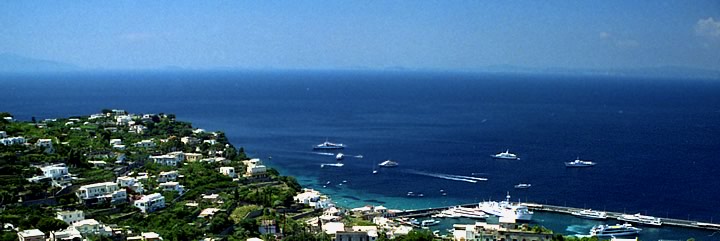

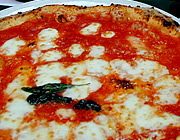
Staying in the Centro Storico in Naples we discovered the perfect pizza, a fabulous Caravaggio, manic street life, underground excavations, fantastic Roman mosaics, the bluest of seas around Capri and made a return visit to fascinating Herculaneum.
Rarely do we take photographs of our meals but pizza and ice cream are highlights of a visit to Naples and I just couldn't resist!
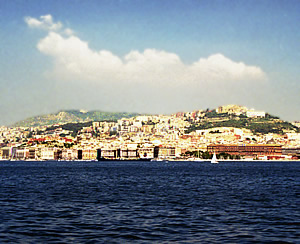
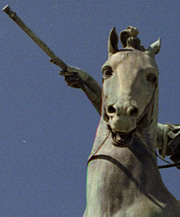
Famed for its beautiful bay, Naples is a city of many faces, ranging from Greco-Roman underground streets to bustling modern arcades.
There has been a settlement here for many centuries but the town of "Neapolis" came into being in the fifth century B.C. as a satellite of nearby Greek-settled Cumae. It was taken by the Romans in 328B.C. and it remained an uneasy Roman conquest for 800 years when the Goths and then the Byzantines invaded. The city became increasingly wealthy and independent and an attractive target for attack.
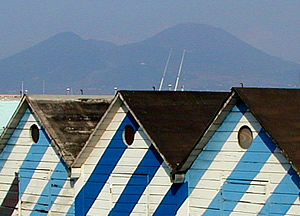
Periods of Norman, Germanic, French, Spanish and Austrian rule through the centuries eventually led to the Neapolitans voting to join Italy, newly united by Garibaldi, in 1860. Earthquakes, eruptions and cholera outbreaks have all taken their toll in the area, though Naples was largely unaffected by the huge eruption of Vesuvius in 79A.D. which buried Pompeii and Herculaneum.
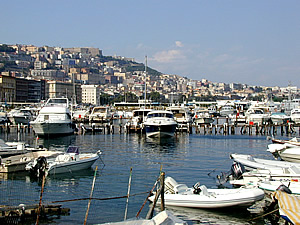
The little port of Mergellina to the west is lovely to wander around - we had excellent chocolate ice cream at Chalet Ciro.
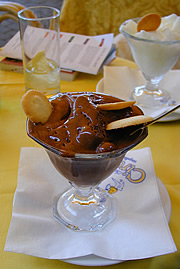
The Centro Storico is the oldest part of the city where the Roman grid plan of streets is still a marked feature. Here the tall, crowded buildings and narrow, noisy, bustling streets are quintessential Naples. Under the churches, shops and apartments lies a subterranean world.
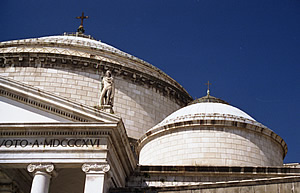
The early nineteenth century Chiesa di San Francesco di Paola dominates Piazza del Plebiscito - a striking white building which stands opposite the Palazzo Reale in a traffic-free zone.
Good ice cream at Scimie just north of the piazza, though we felt the chocolate at Scimie in the Centro Storico was better. Here the feel of the city becomes much more modern with its busy stores and arcades.
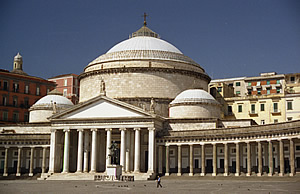
Essential to see a famous painting by Caravaggio, one of my favourite artists.
Caravaggio fled to Naples when he killed a man in Rome and though he didn't stay here long he painted several important paintings, including the "Seven Acts of Mercy" which is in Pio Monte della Misericordia on via dei Tribunali in the Centro Storico. It is an amazing, complex work, commissioned as an altarpiece for the church in which it has remained for 400 years. The seven merciful acts recognised by the Catholic Church were: feeding the hungry, visiting prisoners, clothing the naked, burying the dead, caring for the sick, giving hospitality to pilgrims and providing drink for the thirsty. These are all depicted in the painting in a number of wonderfully executed integrated cameos http://www.caravaggio-foundation.org/Seven-Works-of-Mercy.html
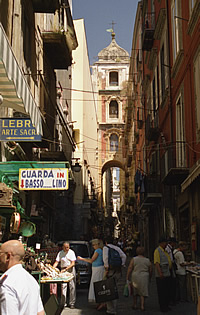
We stayed in the small Hotel Neapolis on via del Giudice just off Via dei Tribunali in the centre of the Centro Storico. Only a three star hotel but in a great location, much of what we wanted to see, apart from the bay, was in very easy walking distance.
One of the more famous streets in the Centro Storico is the street of the nativity makers: Via San Gregorio Armeno. The nativity scenes and cribs (presepe) are an important part of Christmas here.
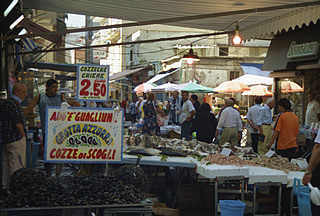
The bell tower over the street is the 17th century addition to the 8th century monastery of San Gregorio, founded by religious refugees of the Byzantine Empire. In the 11th century the monastery had already been combined with two chapels to form a Benedictine order.
To visit San Gregorio we had to ring a bell at the entrance gate and a nun came down to let us in. The tall umber walls of the monastery shelter the cloister gardens - a very peaceful place. All we could hear when we visited was the chanting of school children - the noise of Naples had simply disappeared.
There are street markets in this old part of the city selling all kinds of food; needless to say the sea food looked very fresh but otherwise this wasn't the most memorable market we've seen.
The church of Santa Anna dei Lombardi is rather a grim building, the little of what remains of a monastery, but the attractions are all on the inside. When we visited it was undergoing restoration but we were shown around by one of the conservators and were able to see a beautiful carved Annunciation altar piece (Benedetto da Maiano, 1442-1497), a remarkable set of eight life-size terracotta figures of a Pieta (1492 by Guido Mazzoni), and some magnificent marquetry panelling (attributed to Giovanni da Verona and others, 1506-10) in the old refectory. It used to have three Caravaggios but these were destroyed in an earthquake (http://faculty.ed.umuc.edu/~jmatthew/naples/mischurches.htm). We were not allowed to take photographs here.
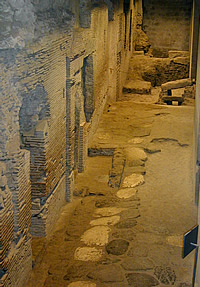
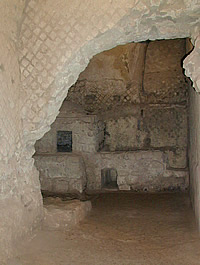
This is a fascinating glimpse into the ancient city. Deep beneath the foundations of this church in the Centro Storico lie the excavations of Greco-Roman streets. We were virtually alone down here and it was amazing to think we were actually walking on the cobbled streets of ancient Neapolis.
It's not a huge site but a large section of the first century A.D. market has been extensively uncovered, with all kinds of shops.
The main street through the market, about 54m long, connected Decumano Maggiore (which is now Via dei Tribunale at gorund level) on its northern side with Decumano Inferiore (now via San Biagio di Librai) on the south.
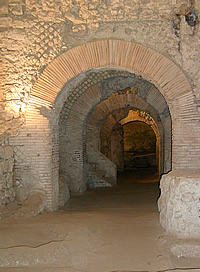
On the south side is a five chambered structure, called a Criptoportico - a covered corridor. Each chamber contains a small ceiling "skylight" and two large tufa blocks. The blocks are set either side of the central axis of the chamber and the upper surface of each block is cut to slope on one side.
The function of these intriguing spaces is unknown - guesses range from fish shops with the slabs sloping so that water could drain off, to some kind of treatment rooms where the slabs were actually beds.
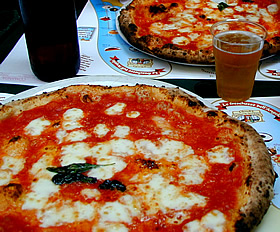
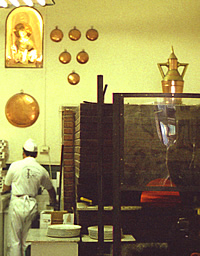
We were on a mission to find the perfect pizza and by complete chance we found it at the first time of trying. Dell' Angelo's is definitely where it's at. Of course it is always going to be a subjective viewpoint but for us these were perfection. My favourite pizza is Margherita and I like it with lots of good tasting tomato sauce and first-rate mozzarella. This is an area where both these ingredients can be found. The best Mozzarella we have ever had was in Paestum, south of Naples - Campania is renowned for its buffalo milk mozzarella.
The best tomatoes for pizza, we have learned, are San Marzano tomatoes. I have grown these in Switzerland but they just don't have the great taste of those grown here - it is apparently essential that they are grown on volcanic soil. These ingredients combined with a perfect base are sheer heaven for pizza-lovers.
Da Micheli's had been recommended by various sources too but, although good, we felt dell'Angelo's definitely had the edge - we'd go back to Naples for this pizza alone!


The main reason to come here was to see artifacts from Pompeii and Herculaneum, particularly the Alexander mosaic. In fact it was the mosaics above anything else I saw which I found wonderful.

The Alexander mosaic is perhaps the single most impressive item here. It is thought to be a late 2nd century B.C. copy of either an earlier painting contemporary with the time of Alexander, or a late 4th century B.C. fresco. It was found in the House of the Faun in Pompeii in 1831 together with many other fabulous mosaics displayed here in the museum. Originally it would have been on a floor.
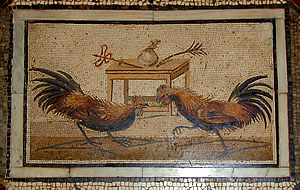
The mosaic depicts Alexander and Darius III of Persia in battle around 330B.C. Alexander rides his famous horse, Bucephalus, and Darius is in a chariot.
There's lots of erotica from the archaeological sites too. The Romans had a very celebratory and humorous attitude to this aspect of life. The museum has a great deal to see including some magnificent sculpture - the Farnese Bull is probably the most famous piece, but we managed to miss it!
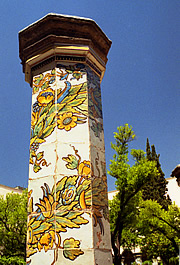
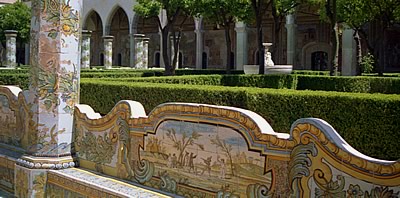
Though the church of this complex on the south side of Piazza del Gesù in the Centro Storico was seriously damaged by bombing in the Second World War (now reconstructed), thankfully the 14th century cloisters were spared.
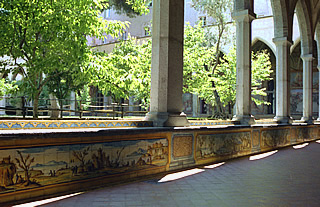
The cloisters are very beautiful, with wonderful 18th century majolica tiled seats, low walls and octagonal columns surrounding a quartered space of grass and citrus trees, an amazingly peaceful spot in the middle of the noisy, busy city.
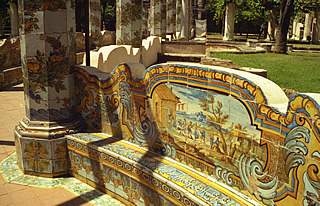

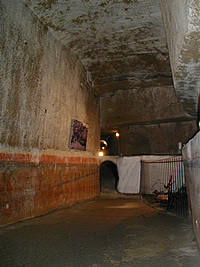
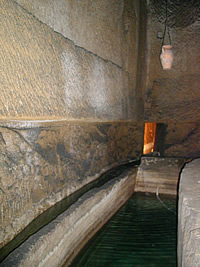
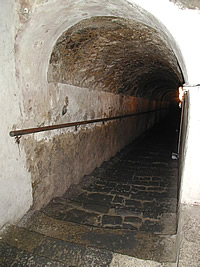
We first became aware that there was a system of aqueducts beneath Naples in Robert Harris's excellent book "Pompeii". Seeing them was high on our "to do" list. They can only be visited in an organised tour - I certainly wouldn't want to go down there on my own, it would be very easy to get lost.
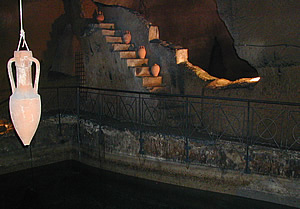
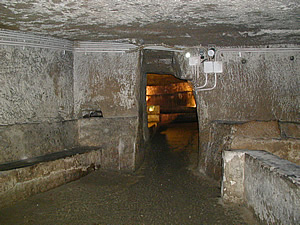
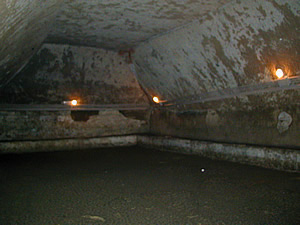
First we visited the remains of a Roman theatre which is also underground. It is reached by entering one of the houses in the Centro Storico and moving aside a bed in a corner of one of the rooms. Here there is a trap door in the floor which, when opened, reveals a long flight of steps going down into the earth. The theatre was very large and it is said that Nero himself performed in his own operas here. The remains aren't particularly inspiring, though. However, this certainly couldn't be said of the underground water transport and storage systems - the cisterns and aqueducts - that we then went on to see.
The Greeks quarried into the ground for tufa blocks with which to build the city - building over the very quarries which they had created. Later the Romans continued to dig, but their purpose was solely to do with providing the city with a reliable water supply. Hence they carved huge cisterns and long aqueducts. The system was further enlarged in the 17th century to meet the needs of the growing city, but was closed in 1884 because of a cholera epidemic.
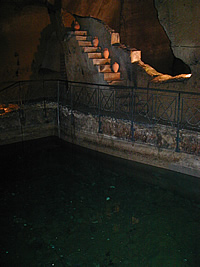
With an area of around 10,000 square metres below the old city, each house had its own well from which to draw water from the cisterns.
During the Second World War this huge underground area sheltered Neapolitans from the bombing.
Descending 30 or 40 metres below ground to visit these spaces is quite an experience. The highlight was an extremely narrow, perhaps 50cm wide, passage, roughly hacked from the stone and lit only with candles. It was pitch black in places between candles and you just had to carry on with faith - not for the claustrophobic! This led to a huge, atmospherically lit, water-filled cistern.
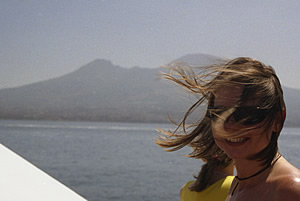
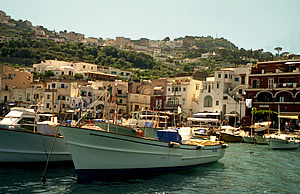
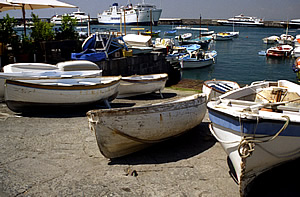
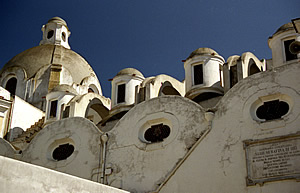
I had long wanted to visit Capri so this was another item high on our list!
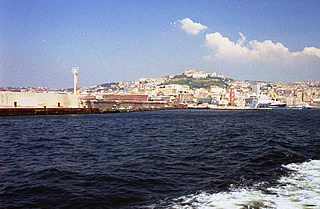
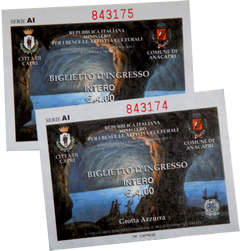
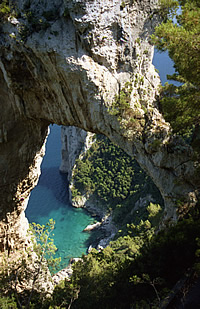
We took the fast boat one morning and landed on the island at Marina Grande, immediately embarking on a smaller boat for the Grotta Azzura - the famous Blue Grotto. Fortunately the sea was as flat as a mill pond because the entrance to the grotto is via a very, very low rock cave. We had to get into a special rowing boat, of which there were many waiting to take tourists, then lie flat in the bottom of the boat as it passed under the cave entrance. But inside it is so magical - the wide expanse of water is an amazing, luminous blue. The fabulous colour is due to light entering via an underwater opening and travelling through the water to the surface.
After lunch (pizza Margherita!) we explored the island a little. Piazza Umberto I at the top of the funicular from the harbour, otherwise known as Piazzetta, was crowded with tourists, but walk away from here in almost any direction and it soon becomes more peaceful. We walked up to Arco Naturale, an impressive natural rock arch high above the beautiful blue waters of the bay.
